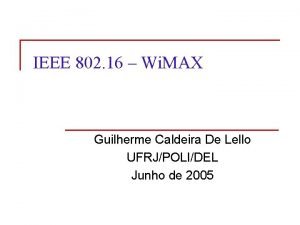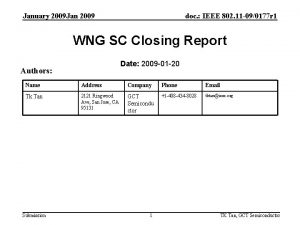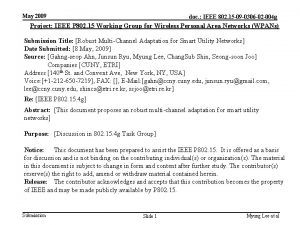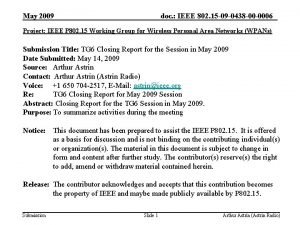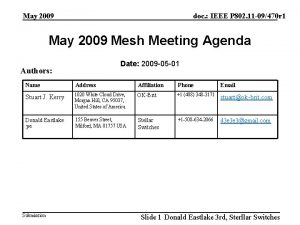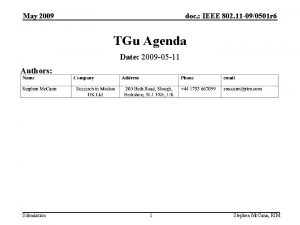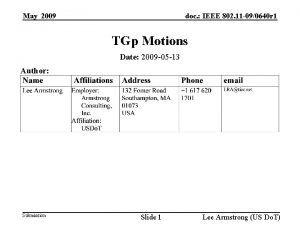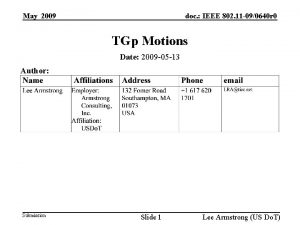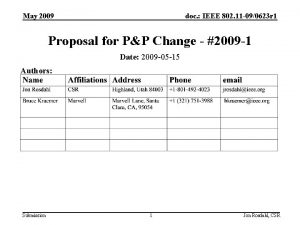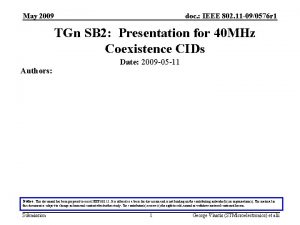May 2009 doc IEEE 802 11 090568 r













- Slides: 13

May, 2009 doc. : IEEE 802. 11 -09/0568 r 0 Response to 802. 15. 3 Coexistence Presentations Date: 2009 -05 -12 Authors: Submission 1 Michelle Gong, Intel

May, 2009 doc. : IEEE 802. 11 -09/0568 r 0 Outline • Motivation • 802. 15. 3 – Architecture and Frame Format • 802. 11 – Architecture and Frame Format • What are needed to support CMS sync frames? • Conclusion Submission 2 Michelle Gong, Intel

May, 2009 doc. : IEEE 802. 11 -09/0568 r 0 Motivation • In the March IEEE meeting, Common Mode Signaling (CMS) sync frame defined in 802. 15. 3 c was introduced as an inter-system coexistence mechanism – IEEE 802. 11 -09/0370 r 1 – IEEE 802. 11 -09/0372 r 0 • The goals of this presentation are: – To give a high level overview of 802. 15. 3 and 802. 11 architectures and frame formats – To explain why TGad shouldn’t be required to support CMS sync frame Submission 3 Michelle Gong, Intel

May, 2009 doc. : IEEE 802. 11 -09/0568 r 0 802. 15. 3 Architecture PNC: Pico. Net Coordinator Neither PNC nor DEV bridges data for other DEVs. All data communications are within the piconet only Submission 4 Michelle Gong, Intel

May, 2009 doc. : IEEE 802. 11 -09/0568 r 0 802. 15. 3 MAC Frame Format Octets: 2 2 1 1 Frame Control PNID Dest. ID Src. ID 3 1 Fragmentation Stream Control Index 0 or 4 Frame Payload FCS MAC header • 802. 15. 3 MAC general frame header is 10 octets – 2 -octet PNID indentifies the piconet • PNID is generated by the PNC that starts the piconet – 1 -octet DEVID, i. e. Dest. ID and Src. ID • PNC assigns a DEVID to a DEV upon association • 802. 15. 3 does not support data communication among different piconets – Therefore, a DEVID that can uniquely identify a DEV within the piconet is sufficient Submission 5 Michelle Gong, Intel

May, 2009 doc. : IEEE 802. 11 -09/0568 r 0 Frame Header for 15. 3 c CMS • PHY header and MAC header are combined together • The parity check is performed over the combined header Submission 6 Michelle Gong, Intel

May, 2009 doc. : IEEE 802. 11 -09/0568 r 0 802. 11 Architecture BSS: Basic Service Set AP: Access Point ESS: Extended Service Set DS: Distribution System DSS: Distribution System Service IBSS: Independent BSS • Ad hoc networks such as IBSS, mesh, etc. define new sets of functionalities but they also maintain backward compatibility with the basic 802. 11 architecture Submission 7 Michelle Gong, Intel

May, 2009 doc. : IEEE 802. 11 -09/0568 r 0 802. 11 MAC Frame Format 0 or • 802. 11 MAC data frame header is 30 or 36 octets long and increasing – It contains various control fields, a duration/ID field, and three or four address fields (pre-TGs) • The MAC address field contains the IEEE 802 48 -bit address – Each MAC address uniquely identifies a STA globally, which guarantees that each STA is uniquely addressable within the ESS – BSSID, set to the MAC address of the AP, is a globally unique identifier too Submission 8 Michelle Gong, Intel

May, 2009 doc. : IEEE 802. 11 -09/0568 r 0 802. 11 PPDU Frame Format PLCP Preamble PLCP Header MAC Header Frame Body FCS Sent at data rate Sent at basic rate • In 802. 11, the PHY header and MAC header are modulated and coded separately (a fully layered approach) • The PLCP header identifies the duration of the packet to aid CCA • The PLCP header has its own parity check bit or CRC Submission 9 Michelle Gong, Intel

May, 2009 doc. : IEEE 802. 11 -09/0568 r 0 TGad Functional Requirements • Functional requirements of TGad: – [Req 9] The TGad amendment must maintain the network architecture of the 802. 11 system. – [Req 10] The TGad amendment must maintain backward compatibility to 802. 11 management plane. • 802. 11 and its amendments define a rich set of management features that can be reused for 60 GHz networks 802. 11 h/k/r/… 802. 11 MAC 802. 11/e/n 802. 11/a/b/g/j/n/y Submission 10 802. 11 PHY Michelle Gong, Intel

May, 2009 doc. : IEEE 802. 11 -09/0568 r 0 Decoding and Transmitting an 802. 15. 3 c Sync frame requires a “dual-mode” device • In order to process the Sync frame, a TGad device would require – – Submission Support the CMS PHY Support both the 15. 3 c and 802. 11 addressing schemes Support both the 15. 3 c and 802. 11 frame formats This is a “dual-mode” device 11 Michelle Gong, Intel

May, 2009 doc. : IEEE 802. 11 -09/0568 r 0 Distributed synchronization and scheduling are very hard problems • To utilize the sync frame solution, all co-located PNCs need to be synchronized and need to synchronize their schedules – Distributed synchronization is an NP-Complete problem – Centralized scheduling is an NP-Hard problem • Distributed scheduling is even more challenging due to the latency and overhead introduced by communication messaging and the fact that there is no single control entity • Directional transmission, the lossy nature of wireless media, and bursty traffic further complicate the problem • If associated DEVs do not support sync frames, coexistence is hard to achieve in some usage scenarios due to the hidden node problem • Need to evaluate the tradeoff between complexity and performance improvement in practical scenarios Submission 12 Michelle Gong, Intel

May, 2009 doc. : IEEE 802. 11 -09/0568 r 0 Conclusion • As defined in TGad’s functional requirements, TGad needs to maintain the 802. 11 frame format and addressing scheme – As an amendment to 802. 11, the TGad amendment must maintain the network architecture of the 802. 11 system, e. g. infrastructure basic service set, extended service set, access point, and station. – Furthermore the system must maintain backward compatibility to 802. 11 management plane, e. g. association, authentication, security, measurement, capability exchange, and MIB. • Due to the differences in 802. 11 and 802. 15. 3, architectures, frame formats and addressing schemes, TGad spec will be different from the 15. 3 c spec – TGad should not be required to support CMS sync frame Submission 13 Michelle Gong, Intel













